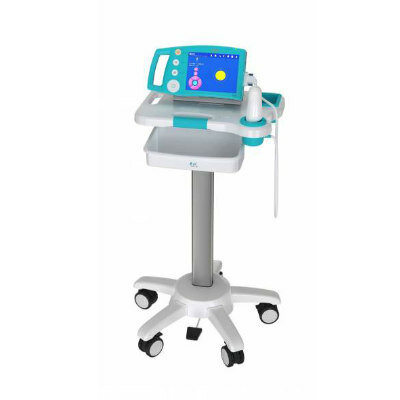Cellphone-Based Microscope Helps Treat River Blindness
|
By MedImaging International staff writers Posted on 21 Nov 2017 |

Image: An adult Loa loa worm (Photo courtesy of UC Berkeley).
A smartphone-connected microscope uses video technology to automatically detect and quantify infection by parasitic worms in a drop of blood, according to a new study.
Developed at the University of California (UC, Berkeley, USA), LoaScope technology is a field-friendly diagnostic tool that turns the camera of a mobile phone or tablet computer into a high-quality light microscope. The technology has applications that incude infectious disease diagnosis, ocean microorganism surveys, eye disease detection diagnosis, and classroom education. For the study, the LoaScope was used to identify persons with Loa loa microfilariae in their peripheral blood with a density greater than 20,000 microfilariae per milliliter of blood.
The quantification was necessary to identify persons if patients suffering from river blindness are also infected with Loa loa before receiving treatment. River blindness is caused by another parasitic worm, Onchocerca volvulus, which is transmitted to humans through bites of infected black flies; left untreated, infections in the eye can lead to blindness. The medication to treat the infection, ivermectin, can be fatal when the patient also has high blood levels of Loa loa. From August through October 2015, 16,259 persons five years of age or older were tested for Loa loa.
The results showed that among study participants who underwent testing, 95.5% received ivermectin, 2.1% were excluded from ivermectin distribution because of an L. loa microfilarial density above the risk threshold, and 2.4% were excluded because of pregnancy or illness. No serious adverse events were observed, and non-serious adverse events were recorded in 934 participants, most of whom (67.5%) had no detectable L. loa microfilariae. The study was published on November 8, 2017, in the New England Journal of Medicine (NEJM).
“This is not just a step forward for efforts to eliminate river blindness, but it is a demonstration that mobile microscopy, based on a mobile phone, can safely and effectively expand access to healthcare,” said study co-author bioengineering professor Daniel Fletcher, PhD. “This work sets the stage for expanding the use of mobile microscopy to improve diagnosis and treatment of other diseases, both in low-resource areas and eventually back in the United States.”
Ivermectin is effective against many different types of parasites, such as head lice, scabies, river blindness, strongyloidiasis, and lymphatic filariasis, among others. It has an added bonus of helping keep malaria-carrying mosquito populations at bay. Discovered in 1975, Ivermectin works by causing an increase in the permeability of the cell membrane, resulting in paralysis and death of the parasite.
Related Links:
University of California
Developed at the University of California (UC, Berkeley, USA), LoaScope technology is a field-friendly diagnostic tool that turns the camera of a mobile phone or tablet computer into a high-quality light microscope. The technology has applications that incude infectious disease diagnosis, ocean microorganism surveys, eye disease detection diagnosis, and classroom education. For the study, the LoaScope was used to identify persons with Loa loa microfilariae in their peripheral blood with a density greater than 20,000 microfilariae per milliliter of blood.
The quantification was necessary to identify persons if patients suffering from river blindness are also infected with Loa loa before receiving treatment. River blindness is caused by another parasitic worm, Onchocerca volvulus, which is transmitted to humans through bites of infected black flies; left untreated, infections in the eye can lead to blindness. The medication to treat the infection, ivermectin, can be fatal when the patient also has high blood levels of Loa loa. From August through October 2015, 16,259 persons five years of age or older were tested for Loa loa.
The results showed that among study participants who underwent testing, 95.5% received ivermectin, 2.1% were excluded from ivermectin distribution because of an L. loa microfilarial density above the risk threshold, and 2.4% were excluded because of pregnancy or illness. No serious adverse events were observed, and non-serious adverse events were recorded in 934 participants, most of whom (67.5%) had no detectable L. loa microfilariae. The study was published on November 8, 2017, in the New England Journal of Medicine (NEJM).
“This is not just a step forward for efforts to eliminate river blindness, but it is a demonstration that mobile microscopy, based on a mobile phone, can safely and effectively expand access to healthcare,” said study co-author bioengineering professor Daniel Fletcher, PhD. “This work sets the stage for expanding the use of mobile microscopy to improve diagnosis and treatment of other diseases, both in low-resource areas and eventually back in the United States.”
Ivermectin is effective against many different types of parasites, such as head lice, scabies, river blindness, strongyloidiasis, and lymphatic filariasis, among others. It has an added bonus of helping keep malaria-carrying mosquito populations at bay. Discovered in 1975, Ivermectin works by causing an increase in the permeability of the cell membrane, resulting in paralysis and death of the parasite.
Related Links:
University of California
Latest General/Advanced Imaging News
- New AI Method Captures Uncertainty in Medical Images
- CT Coronary Angiography Reduces Need for Invasive Tests to Diagnose Coronary Artery Disease
- Novel Blood Test Could Reduce Need for PET Imaging of Patients with Alzheimer’s
- CT-Based Deep Learning Algorithm Accurately Differentiates Benign From Malignant Vertebral Fractures
- Minimally Invasive Procedure Could Help Patients Avoid Thyroid Surgery
- Self-Driving Mobile C-Arm Reduces Imaging Time during Surgery
- AR Application Turns Medical Scans Into Holograms for Assistance in Surgical Planning
- Imaging Technology Provides Ground-Breaking New Approach for Diagnosing and Treating Bowel Cancer
- CT Coronary Calcium Scoring Predicts Heart Attacks and Strokes
- AI Model Detects 90% of Lymphatic Cancer Cases from PET and CT Images
- Breakthrough Technology Revolutionizes Breast Imaging
- State-Of-The-Art System Enhances Accuracy of Image-Guided Diagnostic and Interventional Procedures
- Catheter-Based Device with New Cardiovascular Imaging Approach Offers Unprecedented View of Dangerous Plaques
- AI Model Draws Maps to Accurately Identify Tumors and Diseases in Medical Images
- AI-Enabled CT System Provides More Accurate and Reliable Imaging Results
- Routine Chest CT Exams Can Identify Patients at Risk for Cardiovascular Disease
Channels
Radiography
view channel
Novel Breast Imaging System Proves As Effective As Mammography
Breast cancer remains the most frequently diagnosed cancer among women. It is projected that one in eight women will be diagnosed with breast cancer during her lifetime, and one in 42 women who turn 50... Read more
AI Assistance Improves Breast-Cancer Screening by Reducing False Positives
Radiologists typically detect one case of cancer for every 200 mammograms reviewed. However, these evaluations often result in false positives, leading to unnecessary patient recalls for additional testing,... Read moreMRI
view channel
PET/MRI Improves Diagnostic Accuracy for Prostate Cancer Patients
The Prostate Imaging Reporting and Data System (PI-RADS) is a five-point scale to assess potential prostate cancer in MR images. PI-RADS category 3 which offers an unclear suggestion of clinically significant... Read more
Next Generation MR-Guided Focused Ultrasound Ushers In Future of Incisionless Neurosurgery
Essential tremor, often called familial, idiopathic, or benign tremor, leads to uncontrollable shaking that significantly affects a person’s life. When traditional medications do not alleviate symptoms,... Read more
Two-Part MRI Scan Detects Prostate Cancer More Quickly without Compromising Diagnostic Quality
Prostate cancer ranks as the most prevalent cancer among men. Over the last decade, the introduction of MRI scans has significantly transformed the diagnosis process, marking the most substantial advancement... Read moreUltrasound
view channel
Deep Learning Advances Super-Resolution Ultrasound Imaging
Ultrasound localization microscopy (ULM) is an advanced imaging technique that offers high-resolution visualization of microvascular structures. It employs microbubbles, FDA-approved contrast agents, injected... Read more
Novel Ultrasound-Launched Targeted Nanoparticle Eliminates Biofilm and Bacterial Infection
Biofilms, formed by bacteria aggregating into dense communities for protection against harsh environmental conditions, are a significant contributor to various infectious diseases. Biofilms frequently... Read moreNuclear Medicine
view channel
New SPECT/CT Technique Could Change Imaging Practices and Increase Patient Access
The development of lead-212 (212Pb)-PSMA–based targeted alpha therapy (TAT) is garnering significant interest in treating patients with metastatic castration-resistant prostate cancer. The imaging of 212Pb,... Read moreNew Radiotheranostic System Detects and Treats Ovarian Cancer Noninvasively
Ovarian cancer is the most lethal gynecological cancer, with less than a 30% five-year survival rate for those diagnosed in late stages. Despite surgery and platinum-based chemotherapy being the standard... Read more
AI System Automatically and Reliably Detects Cardiac Amyloidosis Using Scintigraphy Imaging
Cardiac amyloidosis, a condition characterized by the buildup of abnormal protein deposits (amyloids) in the heart muscle, severely affects heart function and can lead to heart failure or death without... Read moreImaging IT
view channel
New Google Cloud Medical Imaging Suite Makes Imaging Healthcare Data More Accessible
Medical imaging is a critical tool used to diagnose patients, and there are billions of medical images scanned globally each year. Imaging data accounts for about 90% of all healthcare data1 and, until... Read more
Global AI in Medical Diagnostics Market to Be Driven by Demand for Image Recognition in Radiology
The global artificial intelligence (AI) in medical diagnostics market is expanding with early disease detection being one of its key applications and image recognition becoming a compelling consumer proposition... Read moreIndustry News
view channel
Bayer and Google Partner on New AI Product for Radiologists
Medical imaging data comprises around 90% of all healthcare data, and it is a highly complex and rich clinical data modality and serves as a vital tool for diagnosing patients. Each year, billions of medical... Read more





















